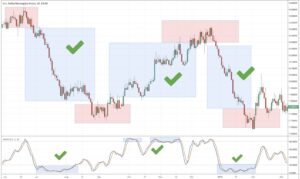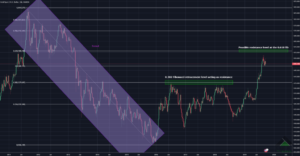The Commitment of Traders (COT) report is a valuable tool that provides traders with a deep dive into the market sentiments and positions of different types of traders. Released weekly by the Commodity Futures Trading Commission (CFTC), this report provides a snapshot of the positions held by commercial and non-commercial traders, along with a breakdown of open interest in various futures markets. For traders interested in understanding market dynamics, the COT report can be an invaluable asset, guiding market analysis and helping refine trading strategies.
In this article, we’ll explore the COT report, discuss its components, and explain how traders can use this information to gain insights into market trends and sentiment.
What is the Commitment of Traders (COT) Report?
The COT report, issued every Friday, summarizes the market positions as of the previous Tuesday for all major futures contracts, including commodities, interest rates, and currencies. The report categorizes traders into three main groups:
- Commercial Traders: These are typically businesses or institutions that use futures contracts to hedge against the risk of price fluctuations in the assets they produce or consume. For instance, an airline company may hedge against the rising price of fuel.
- Non-Commercial Traders: These traders, often referred to as “speculators,” include hedge funds, financial institutions, and individual traders who trade to profit from price changes rather than to hedge a business need.
- Non-reportable Positions: These are smaller traders or individual speculators whose positions are not large enough to be reported individually.
Understanding these categories is essential, as each group has unique motivations that affect how they approach the market. For example, commercial traders usually follow market trends for protection against price risks, while non-commercial traders often aim to profit by taking speculative positions.
Key Components of the COT Report
The COT report is presented in various formats, but two primary formats help traders analyze market positions effectively:
- Legacy Report: The traditional format divides market participants into two categories, commercial and non-commercial.
- Disaggregated Report: This version offers a more detailed breakdown, categorizing positions into Producer/Merchant, Swap Dealer, Money Manager, and Other Reportables, providing a clearer view of market influences.
Each report shows:
- Long Positions: The total number of contracts betting on a rise in price.
- Short Positions: The total number of contracts betting on a decline in price.
- Net Positions: The difference between long and short positions, which helps indicate market sentiment.
How to Use the COT Report for Market Analysis
1. Identifying Market Sentiment
The primary way traders use the COT report is to gauge the general market sentiment. A trader can look at net positions in the report to identify whether the majority of traders are leaning bullish (net long) or bearish (net short). For example:
- If non-commercial traders hold a high number of net long positions, it may indicate strong bullish sentiment.
- Conversely, a high net short position among speculators could indicate a bearish outlook.
By tracking these trends, traders can gauge when sentiment may be reaching an extreme, which could signal an impending market reversal.
2. Spotting Trend Reversals
Extreme readings in the COT report can provide clues to potential trend reversals. For instance, when non-commercial traders are extremely long, it might suggest that a peak is near, as most traders who are bullish have already bought in. Similarly, an extreme short position can indicate a possible market bottom.
Using COT data in conjunction with technical analysis can improve the accuracy of reversal predictions. For example, if a currency pair shows an overbought condition on a technical indicator like the RSI (Relative Strength Index) and the COT report reveals an extreme long position, this dual confirmation may signal an upcoming bearish reversal.
3. Analyzing Commercial and Non-Commercial Behavior
Commercial traders often have deeper knowledge of the markets they trade, as they interact directly with the supply and demand forces driving price movements. When commercial traders increase their long positions, it may indicate that they expect prices to rise, while an increase in short positions might signal an expectation of falling prices.
Non-commercial traders, on the other hand, are often speculators reacting to price changes rather than underlying market fundamentals. Observing the contrast between commercial and non-commercial positions can give traders a sense of where the “smart money” (commercial traders) is moving and how speculative traders might impact short-term price movements.
4. Tracking Historical Data
Traders can examine historical COT data to observe patterns and establish baseline readings for specific markets. By understanding the average long and short positions over time, traders can identify when current positions are unusually high or low, potentially signaling an overbought or oversold market.
Historical analysis is especially valuable for commodities or currencies with seasonal trading patterns. For example, some agricultural commodities have predictable seasonal trends that traders can anticipate by reviewing historical COT data.
5. Pairing with Technical Indicators
While the COT report offers valuable insights, pairing it with technical indicators can improve decision-making. Indicators such as moving averages, Bollinger Bands, and the MACD (Moving Average Convergence Divergence) can help confirm signals from the COT data.
For example:
- Bullish COT Signal with MACD Crossover: If the COT report shows a net long position and the MACD indicator crosses over its signal line, traders might interpret this as a stronger confirmation of a bullish trend.
- Bearish COT Signal with Moving Average Break: If the COT report reveals a net short position and the price breaks below a key moving average, traders could interpret this as additional confirmation of a bearish move.
By integrating COT data with technical analysis, traders can build a more holistic approach to market analysis.
6. Using the COT Report for Forex Trading
Forex traders use the COT report primarily to analyze the sentiment on major currency pairs, especially those with futures contracts on the Chicago Mercantile Exchange (CME). For instance, the report includes data for the euro, British pound, Japanese yen, and Canadian dollar, allowing forex traders to gain insights into the sentiment and positions of large institutions and speculators.
In forex trading, the COT report is often combined with fundamental analysis to assess currency strength. For example, if the COT report shows a strong net long position on the euro while economic indicators suggest a strengthening Eurozone economy, this alignment can boost confidence in a bullish euro trade.
7. Developing a Long-Term Trading Strategy
The COT report can help traders adopt a more patient, long-term approach by focusing on underlying market trends. By reviewing the positions of commercial traders, who are often slower to adjust to market fluctuations but more aligned with economic fundamentals, traders can develop a strategy that captures the broader market direction.
Long-term strategies using COT data might involve:
- Trend-following based on commercial positions: Following the positions of commercial traders over an extended period can guide long-term trades in alignment with underlying economic factors.
- Contrarian positions based on non-commercial extremes: Traders might adopt a contrarian position when non-commercial traders reach extreme long or short positions, anticipating a reversal in the speculative trend.
Tips for Using the COT Report Effectively
- Monitor Changes Weekly: As the COT report is published every week, tracking weekly changes can reveal shifts in sentiment and provide early signals for trend reversals.
- Consider Time Lag: Remember, the report is based on Tuesday’s positions and published on Friday, so market conditions may have shifted by the time it’s released.
- Use in Conjunction with Other Analyses: While powerful, the COT report should be part of a comprehensive trading strategy that includes technical and fundamental analysis.
- Start with a Demo Account: For beginners, practicing COT-based strategies in a demo account can provide valuable experience without financial risk.
Conclusion
The Commitment of Traders report is a powerful resource for traders looking to understand market sentiment, identify potential reversals, and develop long-term trading strategies. By studying the positions of commercial and non-commercial traders, traders can gain insights that enhance their market analysis. When used alongside technical and fundamental analysis, the COT report helps traders make more informed decisions, enabling them to navigate the complexities of the markets more effectively.
With a disciplined approach to analyzing the COT report, traders can integrate this tool into their trading strategies, gaining an edge in the ever-evolving world of trading.
Let’s Have Forex Trade Copying Service From Expert Traders!
Fx Pips Guru is a forex trade copying service provider company from expert traders. Let’s do Live Chat with our experts.




